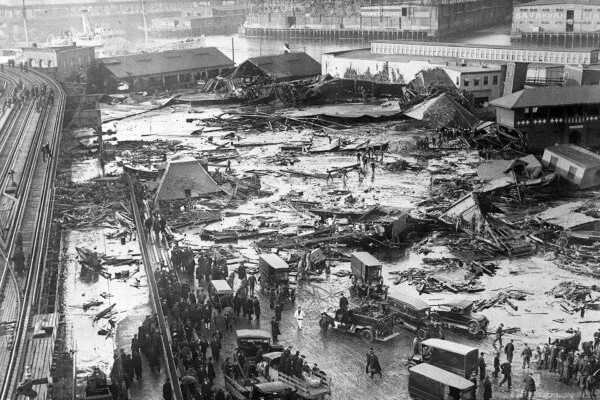
A Most Unusual Disaster: Boston’s Great Molasses Flood Resurfaces

On January 15, 1919, Boston’s North End — a neighborhood rich in Italian American heritage — was the site of a catastrophe that would become infamous in history: the Great Molasses Flood. A massive steel tank containing 2.3 million gallons of molasses burst, sending a 25-foot wave of the sticky substance through the streets at speeds up to 35 miles per hour. This devastating deluge killed 21 people, injured 150 others, and caused immeasurable damage to the densely populated working-class community.
The North End had long been a haven for immigrants, particularly Italians, who had built a vibrant enclave despite facing significant economic and social challenges. Many residents lived in overcrowded tenements near the waterfront, where the tank stood. Owned by the United States Industrial Alcohol Company, the structure had been hastily built during World War I to supply molasses for the production of industrial alcohol, a key ingredient in munitions.
SOURCE: https://orderisda.org
You may be interested
-
9th Annual Sacco and Vanzetti March/Rally
Saturday, August 23rd, in Boston, the 87th anniversary of the execution of Nicola Sacco an...
-
Emanuele: cervello d'Italia al Mit di Boston
Si chiama Emanuele Ceccarelli lo studente del liceo Galvani di Bologna unico italiano amme...
-
Italian world language teacher 2015-2016
FRAMINGHAM PUBLIC SCHOOLS - JOB DESCRIPTION TITLE: World Language Teacher - Italian...
-
'A real Italian experience': Quincy's Italian...
Smoked prosciutto, Buffalo mozzarella, gorgonzola, mortadella, Zeppole di San Giuseppe. Al...
-
'Celebrating Italian heritage': Worcester's I...
Shrewsbury Street was transformed into little Italy Sunday afternoon as community members...
-
'Cello Bar
When life gave them lemons, the Pallini family didn't make lemonade — they made limoncello...
-
'Claudia DeMonte: A World View' Opens August...
Cape Cod Museum of Art will present an exhibition of provocative installations by artist...
-
'I took a shot.' After 35 years, North Truro...
Growing up in an Italian-American household, Robert Montano, chef-owner of Montano's Resta...










